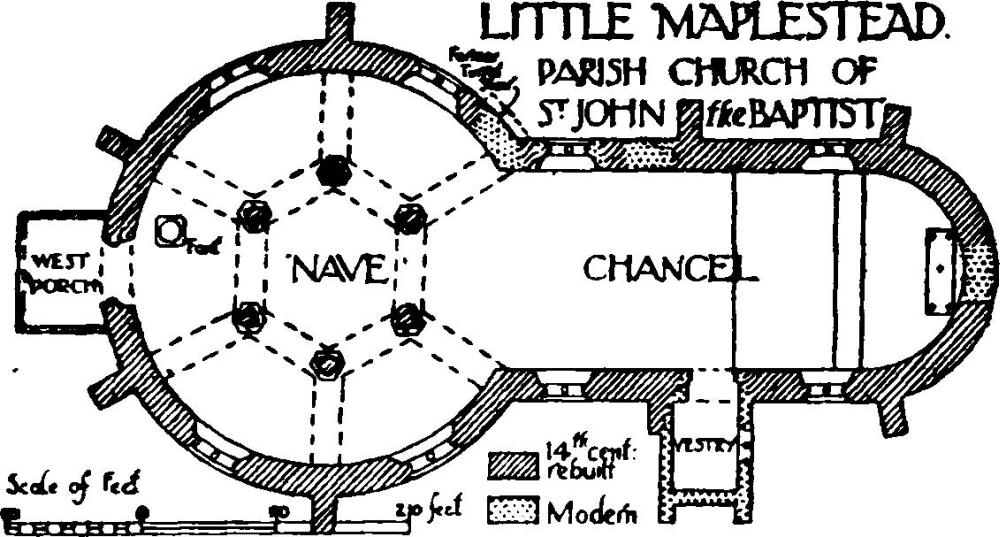Pages 184-185
An Inventory of the Historical Monuments in Essex, Volume 1, North West. Originally published by His Majesty's Stationery Office, London, 1916.
This free content was digitised by double rekeying and sponsored by English Heritage. All rights reserved.
In this section
49. LITTLE MAPLESTEAD. (E.b.)
(O.S. 6 in. xvii. N.W.)
Little Maplestead is a small parish about 2 m. N. of Halstead. The Church is the principal monument.
Ecclesiastical
(1). Parish Church of St. John the Baptist stands by itself towards the N.W. side of the parish. The walls are of flint and pebble rubble with dressings of limestone; the roofs are tiled. It was built as the church of a Commandery of Knights Hospitallers, c. 1340, and consisted of a Chancel and hexagonal Nave with circular aisle. It became ruinous in the 19th century, and was largely rebuilt in 1849–50. The South Vestry and West Porch are modern.
The church (see Plate, p. 184), though practically rebuilt, is of great interest on account of the plan. It has one of the five remaining circular or polygonal naves in England.

Little Maplestead, Parish Church of St. John the Baptist
Architectural Description—The Chancel (35 ft. by 19 ft.) has a semi-circular apse, on which are traces of the blocking of a former E. window. There are two windows in the N. wall, and two in the S. wall, both modern, though the rear arches may be old. In the N. wall between the windows are slight traces of the blocking of a former doorway; in the S. wall between the windows is a modern doorway. There is no chancel-arch.
The Nave (10 ft. average diameter within the arcade and 29½ ft. within the walls of the aisle). is hexagonal, with an arcade of six bays; the two-centred arches are of two slightly wave-moulded orders; the columns are each of three slightly filleted shafts divided by V-shaped projections with modern capitals and bases; the work has been so much scraped that it appears to be completely restored; from each pier springs a two-centred arch, also much restored, which crosses the aisle and rests on carved foliage-corbels in the outer wall. The outer wall has four modern windows and a modern W. doorway. The arcade walls support a modern lantern with a pyramidal roof.
Fittings—Font: Rough bowl, originally square, of limestone, with two round-headed arches on one face, remains of scrolled volute on two faces, and cross on one face, probably 11th-century; angles cut away to form a rough octagon.
Condition—Good, very much restored.
Secular
(2). Hamper's Farm, house, now two tenements, 640 yards S. of the church, is of two storeys, timber-framed and plastered; the roofs are tiled. It was built late in the 15th century on an Lshaped plan with the wings extending towards the S. and E. The Hall is in the middle of the S. wing; late in the 16th or early in the 17th century it was divided into two storeys, and a chimney-stack was inserted at the S. end. There is a modern addition at the end of the E. wing. At each end of the W. front the upper storey projects and is gabled; both projections have original moulded bressumers. Inside the building, the rooms on the ground floor have stop-chamfered ceiling-beams, and in the E. wall of the E. wing is a blocked window of four lights with square mullions set diagonally. In the middle room of the S. wing is a small piece of late 16th-century panelling. On the first floor is the roof-truss of the former Hall, which was of two bays; the truss has a cambered and braced tie-beam, rebated king-post with four-way struts, and a central purlin. The roof of the E. wing has three braced tie-beams.
Condition—Fairly good.
(3). Brick's Farm, house, on the E. side of the road, 1,000 yards E. of the church, is of two storeys, timber-framed and plastered; the roofs are thatched. It was built late in the 17th century, and has a modern addition at the back. The original central chimney-stack is modern at the top. Inside the building, the rooms on the ground floor have stop-chamfered ceiling-beams.
Condition—Fairly good.
(4). Old Bell Cottages, house, now two tenements, 340 yards S.S.W. of (3), is of two storeys, timber-framed and plastered; the roofs are tiled. It was built in the 15th century with a Hall in the middle, a Buttery and a Solar at the ends. Late in the 16th or early in the 17th century the Hall was divided into two storeys, and a chimney-stack was inserted at the S. end. At each end of the W. front the upper storey is gabled, and originally projected; both projections have been under-built. Inside the building, two rooms on the ground floor have open timber ceilings. At the S. end the roof has an original truss which has a braced tie-beam and braced king-post with two-way struts. The roof of the former Hall is of two bays; the original truss has a cambered and braced tie-beam, and a king-post with four-way struts. Part of a former king-post truss remains at the N. end of the building.
Condition—Poor.
(5). The Leys, house, nearly 1 m. W.S.W. of the church, is of two storeys with attics; the walls are timber-framed, partly plastered and partly weather-boarded; the roofs are tiled. It was built probably in the first half of the 17th century, and has a small staircase wing on the W. side. The N. end is possibly a later extension of the original building. The E. and S. walls and part of the W. wall have been re-faced with modern brick. Inside the building, some rooms have chamfered ceilingbeams, and at the top of the staircase is a small piece of original panelling.
Condition—Good.


